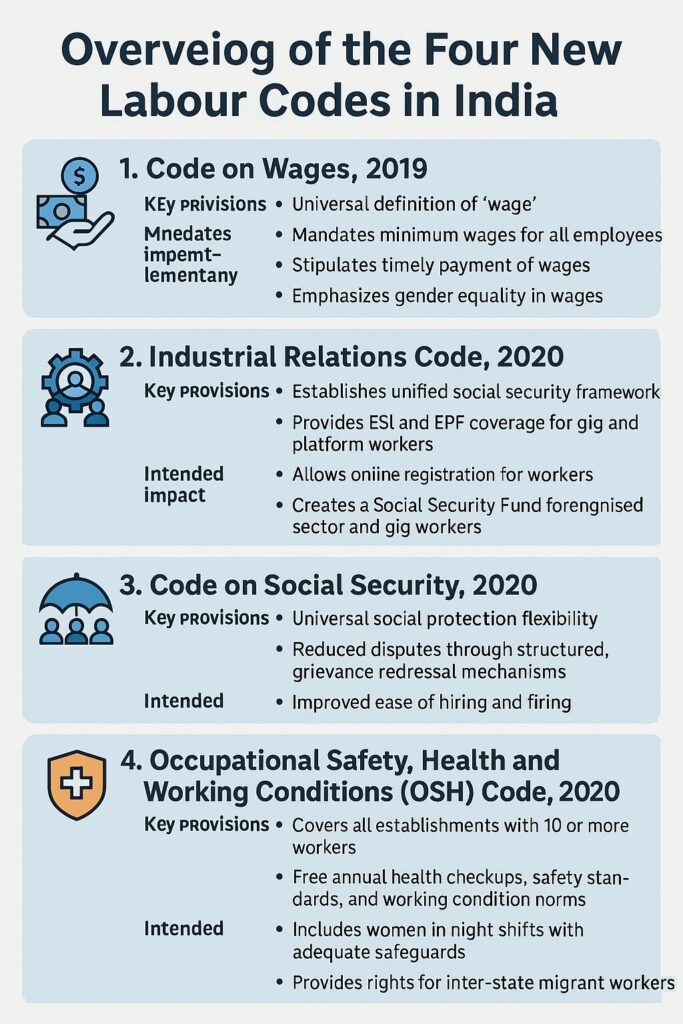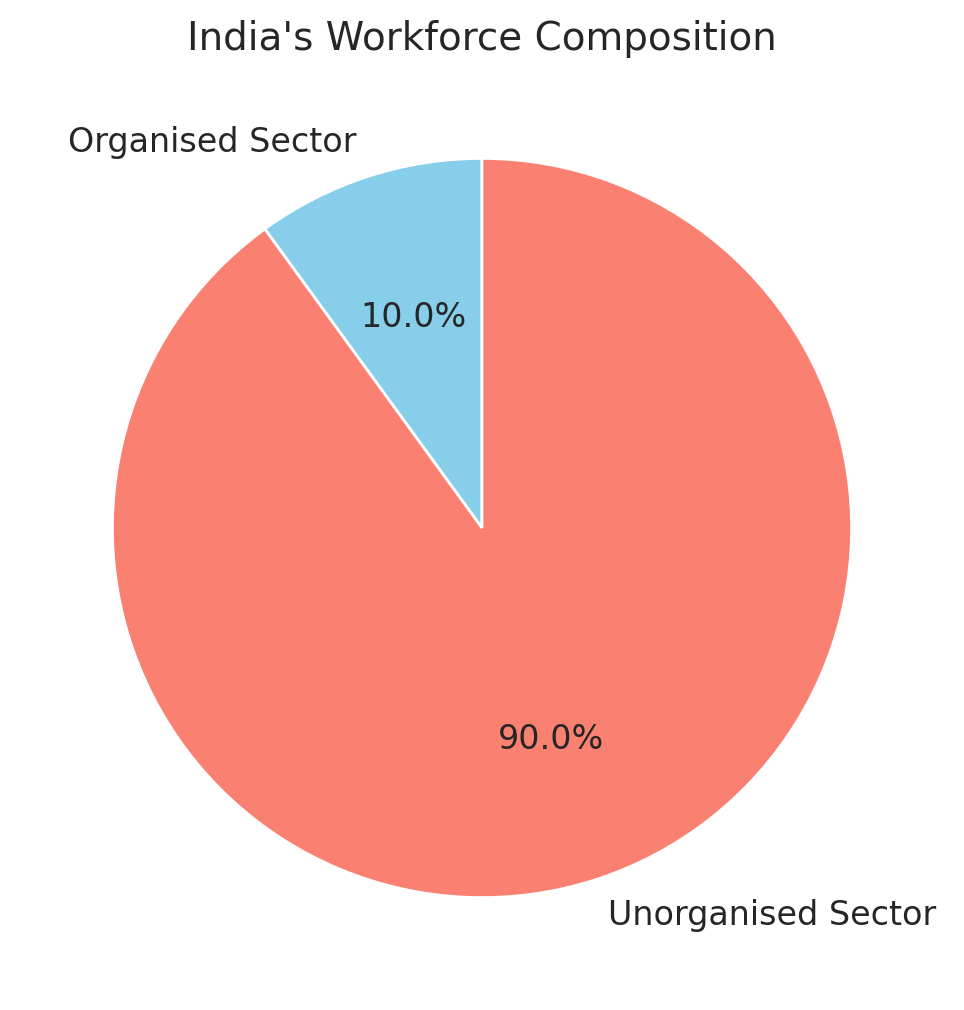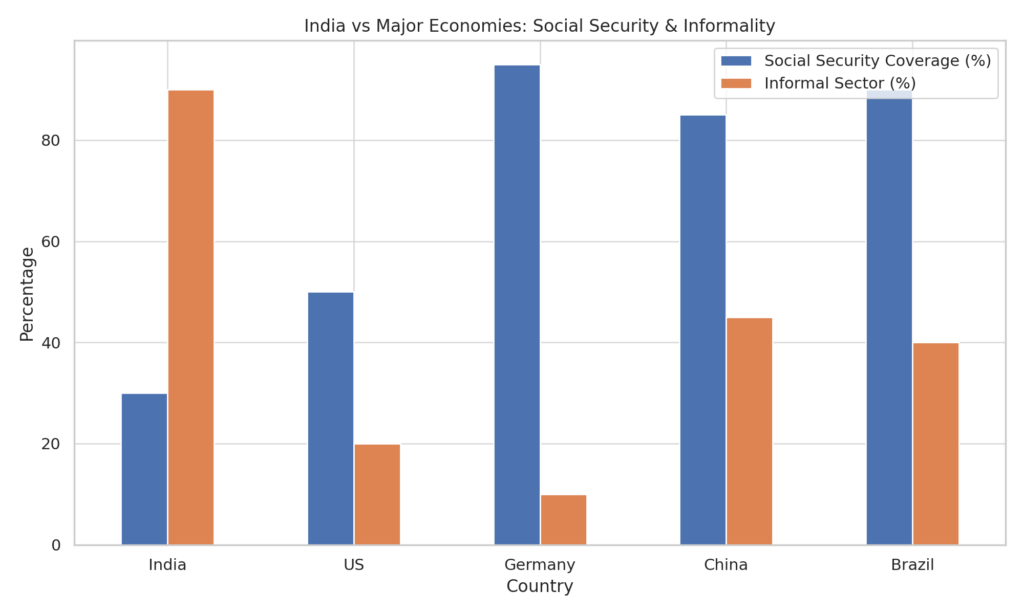India’s Labour Codes: Implementation Status and the Way Forward
1. Introduction
India’s labour landscape has long been governed by a patchwork of colonial-era laws, fragmented across sectors and states, and riddled with inconsistencies. With 29 central labour laws in force before 2019, compliance was burdensome for employers while many workers remained outside the ambit of formal protection. Recognising this, the Indian government undertook an ambitious effort to rationalise and consolidate these laws into four comprehensive labour codes:
- The Code on Wages, 2019
- The Industrial Relations Code, 2020
- The Social Security Code, 2020
- The Occupational Safety, Health and Working Conditions (OSH) Code, 2020
These reforms aim to balance ease of doing business with robust labour protections in a fast-changing economic environment marked by gig work, digitalisation, and an expanding informal sector. This article evaluates the implementation status of these codes, compares India’s labour reforms with large developed and developing economies, and provides a roadmap for their effective rollout.
2. Overview of the Four Labour Codes
2.1 Code on Wages, 2019
- Merges four wage-related laws: Minimum Wages Act, Payment of Wages Act, Payment of Bonus Act, and Equal Remuneration Act.
- Introduces a National Floor Wage to prevent regional disparities.
- Mandates timely payment of wages and prohibits gender-based wage discrimination.
- Applies universally, including to unorganised sector workers.
2.2 Industrial Relations Code, 2020
- Consolidates laws related to trade unions, standing orders, and industrial disputes.
- Introduces fixed-term employment without long-term liability.
- Raises the threshold for government permission for layoffs from 100 to 300 workers.
- Redefines strike protocols and requires prior notice.
2.3 Social Security Code, 2020
- Merges nine different social security legislations including EPF, ESI, Maternity Benefit, and Gratuity Acts.
- Extends coverage to gig, platform, and unorganised sector workers.
- Proposes a National Social Security Board.
- Offers optional schemes for self-employed workers.
2.4 Occupational Safety, Health & Working Conditions Code, 2020
- Merges 13 labour laws relating to working conditions, health, and safety.
- Standardises safety norms across sectors including factories, mines, construction, and plantations.
- Mandates annual health check-ups, safety training, and working hour limits.
- Emphasises safety of inter-state migrant workers and women in night shifts.

3. Current Implementation Status
Although the codes have been passed by Parliament (2019–2020), they have not been implemented yet because both central and state governments need to notify the rules.
3.1 Central and State Preparedness
- As of mid-2025, 30+ states/UTs have pre-published draft rules.
- Gujarat has notified the OSH code.
- Punjab and Chandigarh have amended provisions like overtime limits and exemptions for small factories.
- The Centre has not set a formal nationwide rollout date.
3.2 Barriers to Implementation
- Labour is a concurrent subject under the Constitution, requiring both state and central consensus.
- Some states (e.g., West Bengal, Meghalaya) delayed drafting rules.
- Trade unions accuse the government of bypassing social dialogue and undermining workers’ rights.
- Administrative readiness—such as inspector training, grievance redressal systems, and digital infra—is lacking.

4. Impact on Stakeholders
4.1 Workers and Informal Sector
- The informal sector accounts for ~90% of India’s workforce.
- Codes aim to formalise employment, but actual enforcement mechanisms are unclear.
- The e-Shram portal has registered over 30 crore unorganised workers, but benefit delivery remains low.
- Gig workers (Swiggy, Uber, Zomato) may receive PF/ESI benefits, but no operational framework yet.
4.2 Employers and Industry
- Codes simplify compliance, with provisions like single registration, self-certification, and consolidated returns.
- MSMEs benefit from reduced restrictions (e.g., layoffs allowed without permission up to 300 workers).
- Lack of uniformity across states increases uncertainty for companies operating nationwide.
4.3 Trade Unions
- Oppose relaxation of labour protections, especially in IR Code.
- Claim that it will reduce unionisation, collective bargaining, and job security.
- Have demanded that the government consult stakeholders and reinstate stronger safeguards.
5. Global Comparisons: Where India Stands
5.1 Developed Economies
| Country | Social Security Coverage (%) | Informal Sector (%) | Collective Bargaining Strength |
| India | 30% | 90% | Medium |
| USA | 50% | 20% | Low |
| Germany | 95% | 10% | High |
| Japan | 90% | 12% | High |
- USA: Flexible hire/fire laws, limited federal labour protections, and gig economy largely unregulated.
- Germany: High levels of worker representation (works councils), generous welfare benefits, and strong unions.
- Japan: Lifetime employment system, but modernising with more fixed-term contracts.
5.2 Large Developing Economies
| Country | Social Security Coverage (%) | Informal Sector (%) | Collective Bargaining Strength |
| India | 30% | 90% | Medium |
| China | 85% | 45% | Medium |
| Brazil | 90% | 40% | High |
| South Africa | 80% | 30% | High |
- China: Centralised enforcement with emphasis on contract employment. Labour contracts mandatory.
- Brazil: Labour cards and universal registration make formalisation more effective.
- South Africa: Pro-worker laws, but employers argue they reduce flexibility and increase costs.
Conclusion: India lags in enforcement, coverage, and worker protections. Its reforms aim to replicate business-friendly elements of the US while aspiring to the inclusivity of EU systems.

6. Challenges in Effective Rollout
6.1 State-Level Divergence
- Federalism means states have flexibility to adopt/amend codes, leading to non-uniformity.
- Some states have liberalised provisions, while others have deferred rollout.
6.2 Administrative Weakness
- Vacancies in labour enforcement offices and lack of training hinder compliance monitoring.
- Example: Labour officer in Bihar suspended for welfare scheme anomalies.
6.3 Legal Complexity
- Overlapping definitions and processes confuse small businesses.
- No unified digital portal across all labour departments yet.
6.4 Worker Awareness
- Many workers remain unaware of their entitlements under the new codes.
- Digital divide in rural areas hampers benefit access.
7. The Way Forward
7.1 Set a National Rollout Date
- The Centre must fix a date for implementation and offer states a compliance roadmap.
7.2 Build Administrative Capacity
- Hire and train more inspectors.
- Develop digital tools for registration, inspections, and benefits.
7.3 Include Informal Workers
- Use the e-Shram portal to register informal workers.
- Link benefits to Aadhaar and bank accounts.
- Collaborate with NGOs for awareness and enrolment.
7.4 Address Gig Worker Needs
- Create a dedicated Gig and Platform Worker Welfare Board.
- Learn from Indonesia (pensions for Gojek drivers) and UK (Uber drivers classified as workers).
7.5 Foster Social Dialogue
- Establish tripartite implementation committees.
- Enable sector-specific feedback and mid-course corrections.
7.6 Monitor and Evaluate
- Develop KPIs for:
- Registration of workers
- Compliance by employers
- Reduction in industrial disputes
- Social security payouts
- Publish state-wise progress reports.
8. Conclusion
India’s labour codes offer a unique opportunity to modernise its workforce ecosystem, reduce informality, and align with global practices. However, unless they are implemented uniformly and inclusively, they risk becoming another layer of policy without impact.
The next 12–24 months are critical. Success requires political will, state–centre coordination, administrative investment, and participatory governance. If done right, these reforms can lead to a more just, productive, and globally competitive Indian labour market.
References
- Ministry of Labour and Employment – https://labour.gov.in/
- Lexology Labour Law Updates – https://www.lexology.com
- Economic Times HR World – https://hr.economictimes.indiatimes.com
- International Labour Organization (ILO) – https://www.ilo.org
- India Briefing – https://www.india-briefing.com
- Change in Content – https://www.changeincontent.com
- IDR Online – https://idronline.org
- Wikipedia – Labour Codes of India – https://en.wikipedia.org/wiki/Labour_codes_of_India